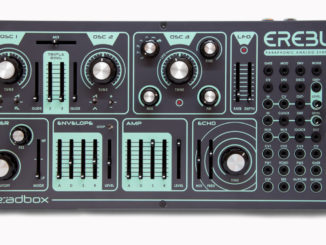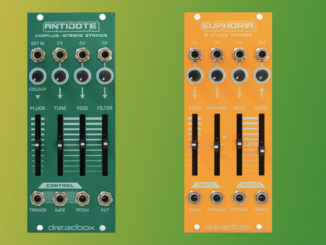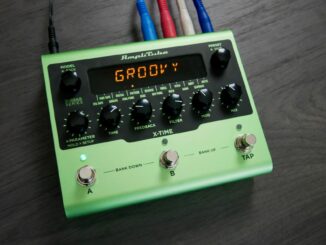Dreadbox Raindrops is a stereo hybrid delay pedal with three creative, colorful facets (modulation pitch shifting, and reverb) full review.
Delays work wonders when used with synthesizers. When the playback is delayed, sounds come to life; they move in the sonic image, and in some cases, they even get shaped. You can never go wrong combining the two.
In my recent expedition into the pedal world, I plunged into a stereo delay from Greece, the Dreadbox Raindrops. Here is my full review.
Disclosure: Dreadbox kindly sent the Raindrops for review
Dreadbox Raindrops Review
Once unpacked, the pedal is in a small fabric box with stickers, a warranty card, and a fabric plectrum. A power supply is not included.
The pedal shines in light blue and pink – a very classic, straightforward design with four Moogy knobs, a switch, and two footswitches. It has two 6.3mm mono sockets on each side, making it a true stereo delay.
Dreadbox markets it as a “hybrid delay” featuring various “analog” chips for the delays and a digital section, including the reverb. It offers three all-stereo algorithms: modulated delays, pitch-shifting delays, and a digital reverb machine.
To set the algorithms, you have to hold down the ON/shift footswitch and press the TAP footswitch. This is simple in theory but a bit suboptimal in practice. Since the pedal does not give any feedback on your active algorithm, you must listen to which one you are in.
The delay is always active in all three modes, with the modifier applied afterward. For example, the sound goes through the delay and then into the pitch shifter or the reverb.
Operation
Raindrops’ operation follows an analog-like concept. Using the four dual-function knobs, you have access to a total of eight parameters. With these, you can tweak the selected delay on the fly. You can access the secondary function not labeled on the interface by pressing the ON/shift (left) footswitch.
I would have preferred to do it with a switch that gives you access to all the parameters on the second page. That way, you don’t have to press the ON button to change a parameter. It would be more accessible from a workflow perspective. Plus, secondary labeling would help a lot.
The following parameters are available:
- time controls the time that goes from 50ms up to about 1 second
- mix: dry/wet mix control
- feedback: the amount of delay repeats.
- control: different parameters depending on the algorithm and the mode switch position
- switch: selects one of the two parameters of the active mode
- effect gain (time 2nd): controls the level of the signal going into the effect’s line – very handy for hot signals
- lowpass filter (mix 2nd): controls a 1-pole cutoff filter
- post feedback (feedback 2nd): the amount of feedback that is sent after the effect’s section (only on modulated and pitch-shifter)
- tap divisions (control 2nd): a multiplication over the tap tempo with fixed areas (x1, x2, x3, and x4)
- tails on/off (switch 2nd)
And if you hold down both footswitches for 3 seconds, you can save a single preset in each algorithm. This is also automatically your new default patch.
Modulated Delays
Without an active modifier, Raindrops produce lovely, clear delay lines. However, the pedal is only clear up to a certain point. From 700ms onwards, it becomes crunchy and Lo-Fi. Max up the time knob and add high feedback, and you have a noise machine.
Dreadbox has given its colorful stereo delay pedal three different algorithms/modes, each offering a distinct flavor of delay—first, a modulated delay, where an LFO modulates the delay time. The control knob controls here either the LFO rate (1) or the LFO amount (2).
Delay and modulation are combinations often used to archive mod effects like chorus, flanging, and vibrato. The Raindrops pedal can also explore this direction. Use short delay times with modulation to get impressive and expansive stereo chorus effects. The grittiness of the delay adds character to it.
I also enjoyed creating “swimming/floating” delay lines with the modulated delay algorithm. It sounds like the delay is on a cruise on the high seas. The algorithm also works beautifully on repeated patterns to add depth and complexity. The LFO’s wide range makes many timbres possible.
Delay + Pitch Shifter / Reverb
Number two on the list is the delay + pitch shifter combo. In this setting, the control knob sets either the pitch (0-12 unquantized semitones) or the pitch shift amount.
This pitch shifter of the Dreadbox Raindrops delivered excellent results in the review, from soft-flowing microtones to freaky audible resonating timbres.
Beneficial are two separate feedback controls, giving much flexibility. So you can infuse lots of feedback on the main delay, but minimal on the pitch-shifted version. Adding more on the second gives you lovely cascaded pitch-shifted delay repeats. So, minimal influence or all-in the shimmering, psychedelic trip.
The third and final algorithm is delay + reverb, which adds a long, ambient reverb to the delay. The control knob adjusts here either the reverb decay mode or the reverb mix. I’m sorry about the other two. This is the algo for synth players.
It wraps the initial delay in a beautiful, long, smeary reverb cloud, perfect for ambient sounds. Use the delay in its lo-fi (700ms+) area and add the modifier; you get a lovely, characterful ambiance.
Additionally, you can shape the reverb with the built-in filter to your taste. And since you can also use the reverb standalone, you have two effects in a box
Three high-quality algorithms, each with its own charm and influence on the stereo image. All three were convincing in the test and are a lot of fun to use.
Self-Oscillation?!
Another strength of the Dreadbox Raindrops should not be forgotten in this review: the feedback control and the self-oscillation. Firstly, I like that there are two different feedbacks, which you can use to adjust much of the signal path.
Turn them up high, and you will discover self-oscillation. The Raindrops handle this very well. I could tune the pitch of the self-oscillation with the time knob, which is often not possible with other pedals.
Dreadbox Raindrops Review Conclusion
The Dreadbox is a lovely, high-quality stereo delay at a fair price. The three modes offer many sound possibilities with enough scope for fine adjustments.
The analog-style interface is welcome and allows you to tweak parameters on the fly. It reminded me of tweaking an analog synth, only here it’s a delay pedal. But it also has its limits. Lack of visualization of some functions (algorithm…), no labeled secondary functions, and the knob combos are rather not conducive to the workflow.
Painfully missing, especially for Synthesizer players, is the lack of MIDI support to keep your delays in sync. In summary, it is a convincing stereo hybrid delay pedal. Not only is the packaging colorful, but so is the content and the core – anything but a classic delay.
Pro
- built quality
- algorithm quality
- stereo image
- flexibility (three different algorithms)
- hands-on but…
- price
Contra
- no MIDI for sync
- operation workflow (algorithm switching, secondary functions..)
Dreadbox Raindrops is available now for $299/259€ worldwide.
More information here: Dreadbox
Available at my partners








Enjoyed reading the review! keep them up!